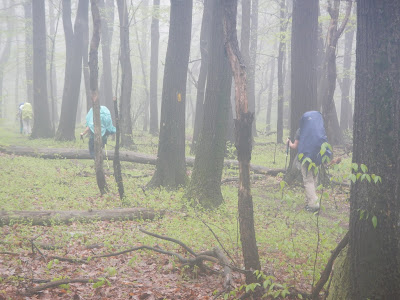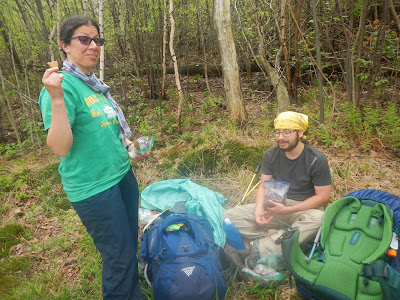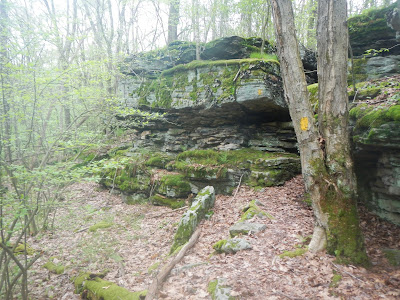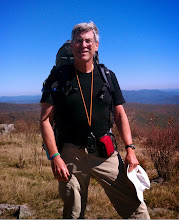I've had this goal of hiking the Laurel Highlands Hiking Trail in Western Pennsylvania for a long while, and on May 16, I gathered for lunch in Ohiopyle, PA (location of the Frank Lloyd Wright masterpieces Falling Water and Kentuck Knob) with my 10 companions for the hike. We were eager to get underway, and it hadn't rained all day after a solid week of rain in that area. The trail runs for 70 miles, and is located here, near where Pennsylvania, Maryland, and West Virginia all meet. I've circled Pittsburgh, the trail being to the southeast of the Three Rivers City.
The shuttle company dropped us off at the trailhead about 3:00, and we got our packs on and gathered for a group photo just as the rain started.
We had 70 miles to go, walking north to south, but only about 6 miles to the campsite, mostly a steady uphill.
The rain fell at a steady pace, but it was too warm for a rain coat, so I took mine off and stowed it in my pack. I also didn't have a rain cover for my pack (something that I have since corrected), so I got drenched and my 40 pound pack slowly gained weight from the rain. I got a photo near the start of the trip.
Here is a track of the first two days of hiking. We camped at the two little blue rectangles the first two nights. Camping has to be reserved and paid for, and one can only camp at the formal campgrounds. Counting the distance to the campgrounds, we hiked 6.3 miles on day 1 and 10.5 miles on day 2.
Spring is well underway in the Laurel Highlands. There were supposed to be several great viewpoints overlooking the river, but it was too rainy to see anything.
Soon enough, we reached the campground for the night. Here is a view of a couple of shelters. It was a rainy Wednesday night, and no other parties were in the campground, so we used some of the additional shelters.
I had this one for myself the first night. The other nights, I shared a shelter with from one to three other people. Four is really about the most that you want in there.
This area had a really nice stream and wonderful wildflowers. After a peaceful and rainy night, we all ate breakfast, packed up, and hit the trail about 9:00. It wasn't raining, but in my wet clothing, it almost didn't matter. One of the things I learned from this trip is the amount of chafing one can get wearing wet clothing, and the need to attend to that and carry extra first aid supplies. These add a bit to the weight, but I would have been hurting if others hadn't had some of the things that helped. The trail was mostly through thick forest in Penn's Woods.
The trail is very well marked with yellow blazes every hundred feet or so for all of its 70 miles.
Lunch time on the trail! The weather was improving, and it was a chance to take the pack off, eat lunch, and - in my case - tape some hot spots on my feet that were going to become blisters from my wet socks if I didn't care for them.
It had cleared enough by mid-day that we had a partial view.
Before we knew it, we hit the 60 miles to go mark,
and not too many miles after that, we were in camp. This was my least favorite campground. There were a lot of swampy areas, and the mice in the shelter drove us kind of crazy all night long. But all in all, it was still nice, and the rain was still absent, although my boots were still soaked. And there was beautiful bird song in the evening and morning. All along the hike, I noted each time that I heard a new bird species, and I ended up with about 30 species for the hike.
The third day of the hike, we followed the track below, hiking about 12.8 miles. The weather was pretty good, except late in the day of hiking, a strong shower moved through, and my finally dry clothing (except for my boots) got soaked again. However, I was wearing rain pants instead of trousers because they didn't chafe as much.
The third day of hiking was the most interesting so far because of the rock formations that we hiked through.
Here is some more of the group on the trail. Everyone is looking pretty happy. Hey, we are having an adventure together - what's not to like?
Along the hike, folks mostly hiked at their own pace, but we tried to meet up at prearranged spots. In this case, we were meeting for lunch at milepost 50 - 20 miles down, 50 to go.
In the afternoon, we passed more cool rocky areas on the way to camp.
April in May!
After more miles, some in the rain, and some going steeply uphill for a while, we reached our third camp, which was near Route 30. By the way, we actually had fair to excellent phone service in five of the six camps. I was able to text home, check the weather radar and forecast, and so forth most nights. We also got kind of lazy about hanging our food. We rarely found good trees so we strung lines in the shelter and hung the food there. We figured that a group like ours would not have bears approaching. But mice and, one night, a flying squirrel, did try to walk across the lines to get into our food supplies.
It was now Friday night, and we had walked about 30 miles. Everyone was a bit wet. The forecast (which ended up being wrong) called for high winds, two inches of rain overnight, and steady rain all of the next day. Everyone had some kind of issue going on after 30 miles, but some had more severe blisters and foot and knee pain, along with some flooding back home. At this point, six of our eleven decided that they had gotten enough of a taste of the Laurel Highlands to try to opt out of the rest of the trip. Because we had good phone service, and because we were only a mile from a major highway, they were eventually able to arrange a shuttle pickup for 10AM Saturday. The other five of us would continue as a group and finish the hike. By about 5:00, the rain had stopped, and it was a nice night in camp with no major mouse issues in our shelters. The camp was full, and every shelter was booked, so we were restricted to our two reserved shelters and a bunch of tent sites.
I also found out at this camping area that a key part to my water filter was missing, and so I had no way to filter drinking water. But that is the strength of being in a group. One of the others had a pretty cool filter with no moving parts, a Be Free from Katadyn (I now have one as well), and she took care of filtering my water the rest of the trip.
I didn't sleep as well, because a large group made a huge ruckus after I had fallen asleep, and once awakened from a sound sleep, I have a hard time getting back to sleep. I did note that it really didn't rain a lot during the night, and I wondered if the next day's rainy forecast might be wrong as well. As it turned out, it was, and the next three days of hiking had pretty ideal weather.
Top 12 Moments in My Racing for a Cure Memories
10 years ago


















































